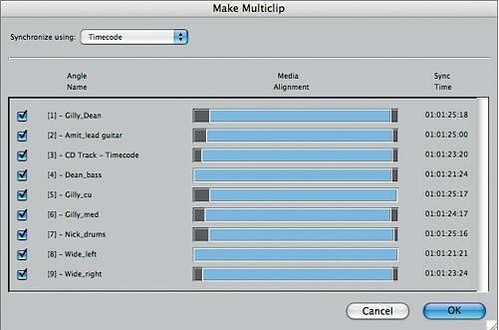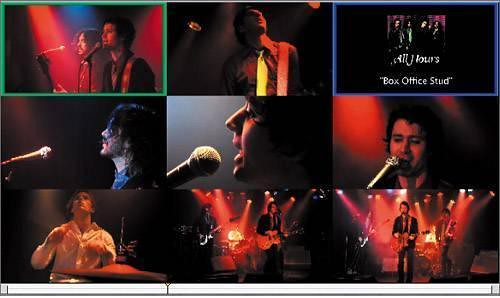 In Final Cut Pro, an alternate way to sync clips of a multi-camera production is to use timecode as a reference. When clips share the same timecode, you don't have to set an In point to sync them together. A timecode number in one clip should identify the same action in an event as that same timecode number in a different clip. The method of switching and cutting angles in the multiclip is the same, no matter how the clips are synchronized.
In Final Cut Pro, an alternate way to sync clips of a multi-camera production is to use timecode as a reference. When clips share the same timecode, you don't have to set an In point to sync them together. A timecode number in one clip should identify the same action in an event as that same timecode number in a different clip. The method of switching and cutting angles in the multiclip is the same, no matter how the clips are synchronized.1. In the Browser, Ctrl-click the Sequences bin and choose New Sequence from the shortcut menu. Name this sequence Timecode, and open it in the Timeline.
Each new sequence you create contains the same PAL settings you chose from the Easy Setup window earlier in this lesson.
2. Hide the contents of the Audio Pops bin, and display the contents of the Timecode bin.
3. Double-click the Gilly_cu clip, and play from the beginning of the clip. When Gilly steps up to the mic to start singing, stop the clip and look at the timecode number in the Current Timecode field in the Viewer.

4. Open a few other clips from the Timecode bin and compare the timecode numbers at the location where Gilly starts to sing.
The same timecode number in all of these clips identifies the same event or clip location. For this group of clips, you can synchronize by timecode, even though they don't all start or stop on the same frame.
5. To make a multiclip of all the clips in the Timecode bin, Ctrl-click the bin and choose Make Multiclip from the shortcut menu.
6. In the Make Multiclip window, click the Synchronize Using pop-up and choose Timecode as the sync option.

The blue bars of each angle reposition to align the clips by timecode. Notice how the blue bars seem to cover the same relative area. They were taken from the same portion of the song but are not exactly the same length.
7. Click OK. In the Timecode bin, rename the new multiclip Timecode, and double-click to open it in the Viewer.
8. In the Viewer button bar, click the Show Multiclip Overlays button to toggle off the overlays in this multiclip.

9. In the Viewer, click the View pop-up and choose Multiclip 9-Up from the pop-up menu to see all the multiclip angles. Play this portion of the music video.

10. To edit this multiclip, use the same process you used with the Audio Pops multiclip. Start by changing the sync to Video+Audio and selecting the CD Track - Timecode clip. Then change the sync to Video and select the first video angle. Set an In point and an Out point where the angles are all in view, and edit the multiclip to the Timeline.
11. To see the clips play in the Viewer as you play the sequence, click the Playhead Sync pop-up, and choose Open from the menu, or press Shift-Ctrl-O. This will allow you to see the angles as you play and cut in real-time.
At this point, you can edit these clips as you did in previous exercises: either by moving the playhead to an exact edit location and cutting to a new angle, or by cutting live.
NOTE
If you are using a laptop or slower computer, this nine-clip multiclip may play slowly.
Digital Filmmaking is the way to go...
3 comments:
hi
watch my first docmentary
and if u like it then pls share the link among ur frnds too since it is a part of a competition
http://www.youtube.com/watch?v=7-LRpRa71j0
i would appreciate ur comments on it.
That the system gives the caller intuitive menus and instruction is a very impressive feature.
A lot of the planning and process is involved in developing a robust online marketing strategy that some might think as more of an industrial process.
Post a Comment